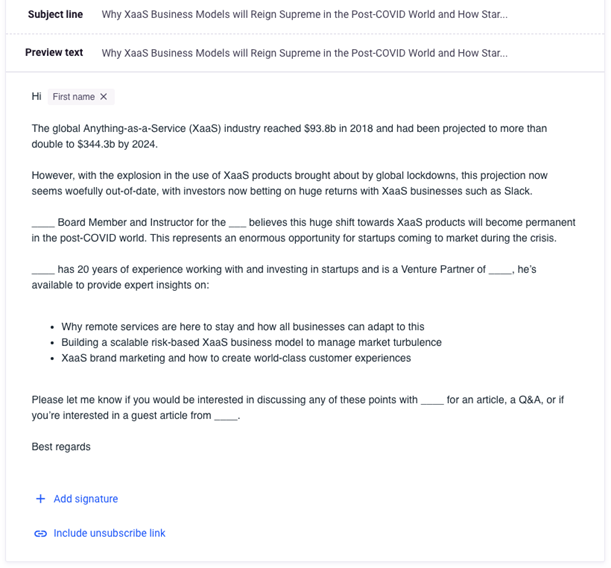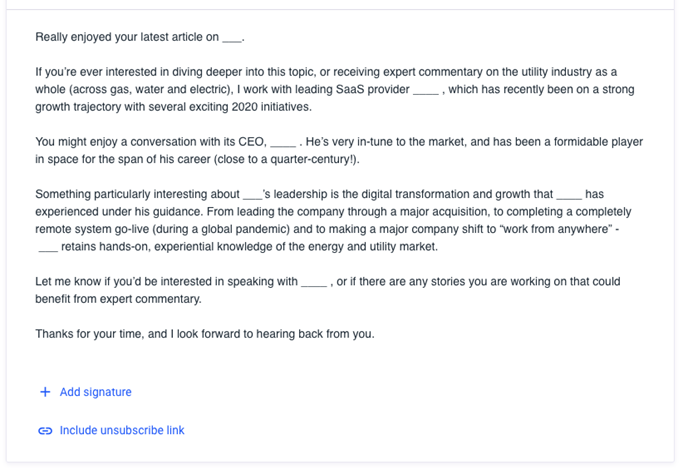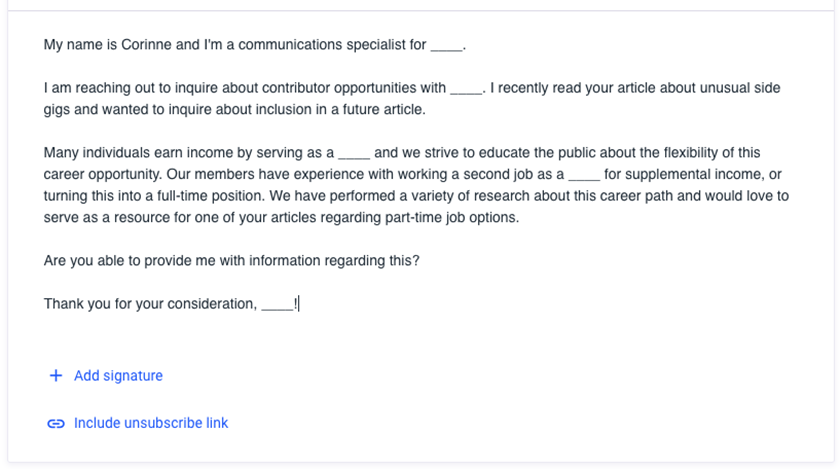
Crafting Compelling a Media Pitch that Grabs Attention
Do you have a new story to share or perhaps wish to get the word out for your new product? Consider a media pitch. It is the art of getting a journalist or an editor interested in your news and enticing them to cover it. This, in turn, helps you obtain the relevant media coverage.
But there is a catch! You simply cannot toss your message in this vast digital ocean and expect a journalist to fish it out. This is because more than 42% of writers receive between 11 and 100 pitches every day. The odds are against you in this competitive realm, my friend!
But fear not; there are ways to make your pitch email stand out. One of which is, of course, through crafting compelling media pitches – those that grab attention! In this blog, we will understand things like –
- What to include in your pitch?
- What to leave out?
- How to increase your chances of getting a reply?
- And more!
So, let’s begin, shall we?
Key Takeaways
- Understand Your Audience: Identify target media outlets and journalists, research their interests, and tailor pitches accordingly.
- Create Attention-Grabbing Subject Lines: Craft concise and engaging subject lines that spark curiosity and personalise when possible.
- Deliver Compelling Pitches: Provide clear, concise introductions, highlight relevance to the audience, and incorporate multimedia elements for impact.
- Build Relationships and Follow-Up: Address journalists by name, offer exclusives or collaboration opportunities and follow up politely and timely across various channels.
Understanding Your Audience
To turn media pitching into a powerful tool, you must first understand your audience. And by that, we mean digging deeper than just understanding who you are talking to. You need to understand what makes them tick, what piques their interest and more. Here is how to do the same –
a. Identify target media outlets and journalists
Take a moment to pinpoint your target. This means understanding journalists and relevant media contacts that hold the keys to your audience’s attention. Do you need a tech-savvy reporter? Or do you need a health-conscious editor?
It is crucial to choose and identify relevant journalists and media contacts with proven track records in your niche. For instance, if you are launching a new fitness app, go for editors who focus on health and wellness for maximum outcomes.
b. Research their interests, beats, and preferences
Now that you are well-versed with the targets, it is time to identify –
- What excites them?
- What topics do they cover religiously? And, so on.
When you understand these things, you gain an insight into the editor’s psyche.
Scour through the editor’s recent articles or follow them on social media. You even indulge in a little light stalking (the professional kind, of course) to dig deeper. The notion behind is to –
- Determine writing patterns
- Identify hints of personal interests
- And note down any pet peeves the editor might have.
Note: The more you know about the editor, the better you can tailor your pitch as per their likings!
c. Tailor pitches to match the needs and interests of each recipient
Now begins the fun part: the crafting process!
It is crucial to note that there is nothing like a “cookie-cutter approach” in the world of media pitching. Something generic will never make the heads turn as you wish.
Hence, you must customise your press release pitch email for the recipient. Highlight things like –
- why your story matters to them specifically
- what sets it apart
- why their audience would care.
Crafting an Attention-Grabbing Subject Line
Your pitch’s subject line is similar to a –
- first impression
- teaser trailer
- hook that reels in the audience
Hence, you must write a media pitch with an attention-grabbing subject line. Here is the science behind the same –
a. Importance of a concise and engaging subject line
The subject line is like the gatekeeper of your pitch. It is the first thing that the editor will see and decide whether or not the pitch is worth reading. Hence, be vigilant in crafting one.
Most typically, you will send your PR pitches via email. Hence, ensure the creation of a concise and engaging subject line. Keep it short and to the point. This is because journalists don’t have time to decipher cryptic messages. They may even overlook lengthy prose.
b. Tips for creating subject lines that spark curiosity and encourage opens
So, how do you craft a perfect subject line? Well, it isn’t rocket science. All you need to do is –
- Create something that gives just enough information to make the editors curious. But not enough to give away the entire story.
- Use numbers and stats, if required, to grab attention.
- Inject a sense of urgency using phrases such as “limited time offer” or “exclusive opportunity.” The idea here is to encourage immediate action.
- Personalise the pitch, wherever possible. For instance, address the editor by name. Or, add details of recent work, thereby showing that you have done your homework.
c. Examples of effective subject lines for different types of pitches
- New Study Reveals Surprising Trends in Consumer Behaviour
- Breaking News: Revolutionary Technology Set to Disrupt Industry Standards
- You’re Invited: VIP Access to the Launch Event of XYZ Company
Each of these subject lines offers a glimpse into the story behind the pitch. They entice the recipient to open the email and learn more. Also, they are short, engaging and impossible to resist!
Crafting a Compelling Pitch

Remember, crafting a compelling pitch is quite similar to telling a captivating story. Hence, it is crucial that you keep the editors hooked from the very beginning. Also, you must keep them engaged throughout and leave them wanting for more.
Here is how you can make your pitch impossible to ignore –
a. Clear and concise introduction of the story or news angle
Always start strong with a clear and concise introduction. This will help your media pitch stand out from the rest. Similarly, get straight to the point instead of beating around the bush. Journalists appreciate brevity and clarity.
Ensure that your intro itself answers the who, what, when and all the questions that journalists might have. Make every word count, given you have just a few seconds to grab the attention.
b. Highlight the relevance and significance of the pitch to the journalist’s audience
Once you have hooked the journalist with your intro, reel them in by highlighting the significance of your media pitch to their audience. Why should they care about your story? What’s in it for their readers or viewers?
Ensure that your pitch is tailored as per the journalists’ beat and audience demographics. You need to show why your story matters. Similarly, it must align with their concerns and interests.
Lastly, use language that speaks directly to their audience. The idea here is to make the journalist feel you are offering them something relevant and valuable.
c. Provide supporting details, data, or quotes to strengthen the pitch
It is crucial that you go beyond just telling the journalist about your story. You must show them its worth. To do so, cover details, data and even quotes. The idea here is to back up your claims with concrete evidence. You must provide context to help the journalist understand the significance of your pitch.
The more supporting stats, studies or expert opinions you add, the better credibility and depth your pitch will have.
d. Incorporate multimedia elements
Finally, consider incorporating multimedia elements. These can be anything from images to videos and infographics. The idea is to enhance the appeal of your pitch with visuals. Also, to bring your story to life and make it shareable.
Just ensure that whatever multimedia you add to your pitch is in line, relevant and professional!
Personalisation and Relationship Building
Both personalisation and relationship building are key to getting your story noticed and preventing it from being lost in the shuffle. Here are tips on how to forge meaningful connections with your chosen journalist –
a. Address the journalist by name and referencing previous interactions or articles
The first step to personalisation is addressing the receiver by their name. So, ensure that your PR pitch addresses the journalist by his/her name. This simple act will show that you have done your research and value their individuality.
And don’t stop there. Go, maybe, an extra mile by referencing previous interactions or articles. Mentioning a recent piece by the journalist will showcase that you are familiar with his/her work. It will also show you are genuinely interested in what they have to say.
b. Demonstrate genuine interest in the journalist’s work and expertise
Make a note: Journalists are very smart. They can spot generic pitches even from a mile away. Hence, showcase a genuine interest in the journalist’s work and expertise.
You can –
- Take the time to read their articles,
- Follow them on social media,
- Engage with their content.
The idea here is to show the expert that you are familiar with their work. Also, you understand the issues and topics that are important to them and their audience.
While drafting the pitch, tailor it to fit the journalist’s interests and preferences. You need to show them that you have done your homework.
c. Offer exclusives or opportunities for collaboration to foster a mutually beneficial relationship
In order to forge a lasting connection with the media outlet or journalist, you must do more than just pitch stories. And by that, we mean you need to find ways to add value. You also must support each other’s goals.
For instance, offer exclusives or opportunities for collaboration. This will help foster mutually beneficial relationships. You can either provide exclusive interviews or co-create content together.
The notion is to provide journalists with something special that they can’t get anywhere else.
Timing and Relevance

In media pitching, timing has a huge role to play. To enhance your chances of success, you must –
- understand the news cycle,
- capitalise on current events,
- and avoid overwhelming journalists during busy times.
Here is how to get your timing just right –
a. Understand the news cycle and timing pitches accordingly
The news cycle refers to the ebb and flow of news stories. This can be throughout the day, week, and even month. With a simple understanding of news cycle’s rhythm, you can time your pitches for maximum impact.
For example, mornings are typically busy for journalists. This is when they are catching up on overnight news and plan their day. Hence, mid-mornings and early afternoon could be excellent times for sending pitches. This is when they are done with their morning rush but haven’t started yet on afternoon deadlines.
Similarly, avoid pitching on Fridays, or even before public holidays, for that matter. As the journalists might be winding down for the week or taking time off. Instead, aim for Tuesdays, Wednesdays, or Thursdays. This is when journalists are more likely to be actively seeking story ideas.
b. Capitalise on current events or trends to make pitches timely and relevant
An effective way of grabbing the journalists’ attention is by tying your pitch to current events or trends. If you are able to connect your story with something that is already trending, you can instantly make your piece relevant and timely.
Hence, keep an eye on news and social media. They could give you chances to piggyback on trending topics. And once you find one, ensure that you insert your story into the conversation in a natural and authentic way.
Remember, your pitch should add value and provide meaningful insights and solutions. Hence, avoid exploiting tragedies or sensitive topics for publicity. It makes zero sense to capitalise on someone else’s misfortune.
c. Avoid pitching during peak times or holidays when journalists may be overwhelmed
Reading the stats mentioned above, we are sure you must know by now that PR professionals or journalists receive hundreds of pitches every day. Hence, it is important that you avoid bombarding them with your pitch during peak times. It will only overwhelm them.
Instead, schedule your pitches for times when the journalists are more likely to review and respond to them. Also, maintain quality over quantity to avoid rejection.
Follow-Up Strategies
Besides properly formatting the pitch and sending it on time, following up is key to increasing your chances of success. But, it is crucial that you do the follow-ups politely and on proper time. This way, you can avoid looking pushy or intrusive.
Here are some tips for the same –
a. Importance of timely and polite follow-ups
Timely follow-ups will ensure your pitch gets noticed and not forgotten. It is easy for your pitch to get lost in the many pitches the journalists receive every day. With a polite phone call or a follow-up email, you can lower those chances and allow the editor to prompt action.
But see to it that you strike the right balance between persistence and patience. Avoid following up too soon or too frequently, as you may risk annoying the journalist. You may even harm your chances of getting the coverage. Similarly, waiting too long to follow up may result in your pitch being overlooked or forgotten.
b. Tips for following up effectively without being pushy or intrusive
- Be polite and courteous in your communications. Also, ensure to appreciate the journalist for even considering your pitch.
- Send a gentle reminder to the journalist about your pitch. Ask if he/she needs extra time to review. Ensure that this message is short and concise.
- You can even personalise the follow-up messages. Do so by referencing previous interactions or articles the journalist has written. The idea here is to demonstrate your genuine interest in their work.
- Avoid sending multiple follow-up messages in quick succession. Give your journalist enough time to review and respond.
- Remember, not every pitch will result in coverage. So, be prepared to accept rejection gracefully. Thank the journalist for their consideration and move on!
c. Utilise different communication channels
Besides email, you can also rely on other communication channels to follow up with the journalist. These can include phone calls or social media.
But before you decide on the communication channel, be sure to research the journalist’s preferred contact method and etiquette. Also, keep your messages brief and professional. And don’t forget to respect their privacy and boundaries.
Handling Rejections and Feedback

Receiving rejection is, of course, disheartening. But the way you handle it matters the most.
Here is how to handle rejections and feedback with grace –
a. Maintain professionalism and resilience in the face of rejection
Even if your pitch gets rejected, be professional and graceful. You mustn’t take rejection personally or even emotionally. Instead, be thankful to the journalist for even considering and reviewing your pitch. You can even express your continued interest in working with them in the future.
Remember, maintaining resilience in the face of rejection is essential for success in PR. As a professional, stay focused on your goals. Also, don’t forget to continue refining your pitching strategy.
b. Seek feedback from journalists to improve future pitches
The best thing about rejection is that it presents you with an opportunity to grow and improve. Hence, consider reaching out to the journalist who rejected your pitch. Then, politely request feedback.
Use the constructive criticism provided by the journalist in your favour. Refine your pitch and increase your chances of success down the line.
Also, while requesting feedback, be respectful of their time and perspective. Keep your request brief and focused. Also, express your genuine interest in learning from their insights.
c. Use rejections as learning opportunities to refine pitching strategies
Instead of viewing rejections as failures, try to reframe them as learning opportunities. With each rejection comes valuable feedback. Use the same to refine your pitching strategies and become a more effective PR professional.
Take time to analyse the reasons behind each rejection. Also, identify any common themes or patterns. Do you think certain aspects of your pitch needs improvement? For instance, the subject line, the pitch’s angle or even the relevance to the journalist’s audience.
Use the gathered information to then adjust your approach and tailor future pitches more effectively.
Case Studies and Examples
Now, let’s spend some time exploring successful media pitches and their outcomes below –
a. Successful media pitches and their outcomes
1. Rudi Davis, Chief Operating Officer at NetPositiveAgency
It is clear from the image below that Rudi used the expertise of his clients and provided expert insights on topics that journalists covered. He even proposed multiple in-depth topics and gave the recipients choice, thereby increasing the success of the pitch.

2. Mary Brynn Millburn, Senior Public Relations Coordinator at Idea Grove
In Mary Millburn’s media pitch example, you can see the emphasis on value proposition. It also offers expert commentary along with fresh information from the CEO of the company.
The result of this was that the journalists obtained compelling content that may resonate with their readers.

3. Corinne McCarthy, SEO & Online PR Specialist at Web Talent Marketing
If you notice, Corinne McCarthy’s successful media pitch letter starts by addressing the writer by the name. It also references a recent article related to the topic. Further inside, we also see a brief description of the angle, highlighting its relevance to the publication.
The outcome of this pitch was the placement of Web Talent Marketing on CNBC’s website.

b. Analyse what made these pitches effective in grabbing media attention
The effectiveness of these pitches can be attributed to several factors, including –
- Personalisation – One thing prominent in these pitches is that they are personalised to each recipient. They address them by name and even reference the writer’s interests or previous interactions.
- Relevance – All of these pitches are tailored to match the needs and interests of the journalists and their target audience. This is what makes them more likely to resonate.
- Value proposition – All of these media pitch examples offer value. For instance, they offer fresh information, expert commentary and even exclusive opportunities. All of which came handy in incentivising journalists to cover the stories.
- Clear and concise communication – All these pitches are well-written. They have clear and concise introductions that capture journalists’ attention from the outset.
c. Extract key lessons and strategies that can be applied to future pitches
- Research and target – Ensure to spend time researching and identifying target media outlets and journalists. Only then can you tailor your pitch for an effective outcome.
- Personalise and customise – Personalise your pitches to the individual recipients. For instance, address them by name. If possible, reference their previous work or interests. Similarly, customise your pitches to highlight the relevance and significance of your story to their audience.
- Provide value – The idea is to provide pitch that benefits both the journalist and his audience. Hence, offer valuable and insightful content. Ensure your pitch features information that is unique, value-adding and worth reading.
- Be clear and concise – Never beat around the bush. Always craft clear and concise pitches so they communicate the essence of your story or news angle effectively. You can even add supporting data to strengthen your pitch.
- Follow-up effectively – Use different and journalist’s chosen communication channels to conduct timely and polite follow-ups. Also, avoid being pushy or intrusive while doing so.
|
Discover the most relevant agencies for your project based on your own specific requirements.
Find an agency!Ending note
For some, media pitching may seem like a complicated, daunting and even intimidating process. But it was quite clear from the blog that isn’t the case. In fact, the success of your pitch depends upon your ability to craft them into compelling pieces.
To ensure your pitch stands out or even sees the daylight beyond the inbox of your chosen journalist, use the tips listed above. Trust us, just by adhering to these tips, you will be able to produce pitches that stand the test of time and also obtain the media coverage you are behind!
So, go ahead and put your newly gained knowledge to the test. Watch your pitches reach their peak like a pro!





